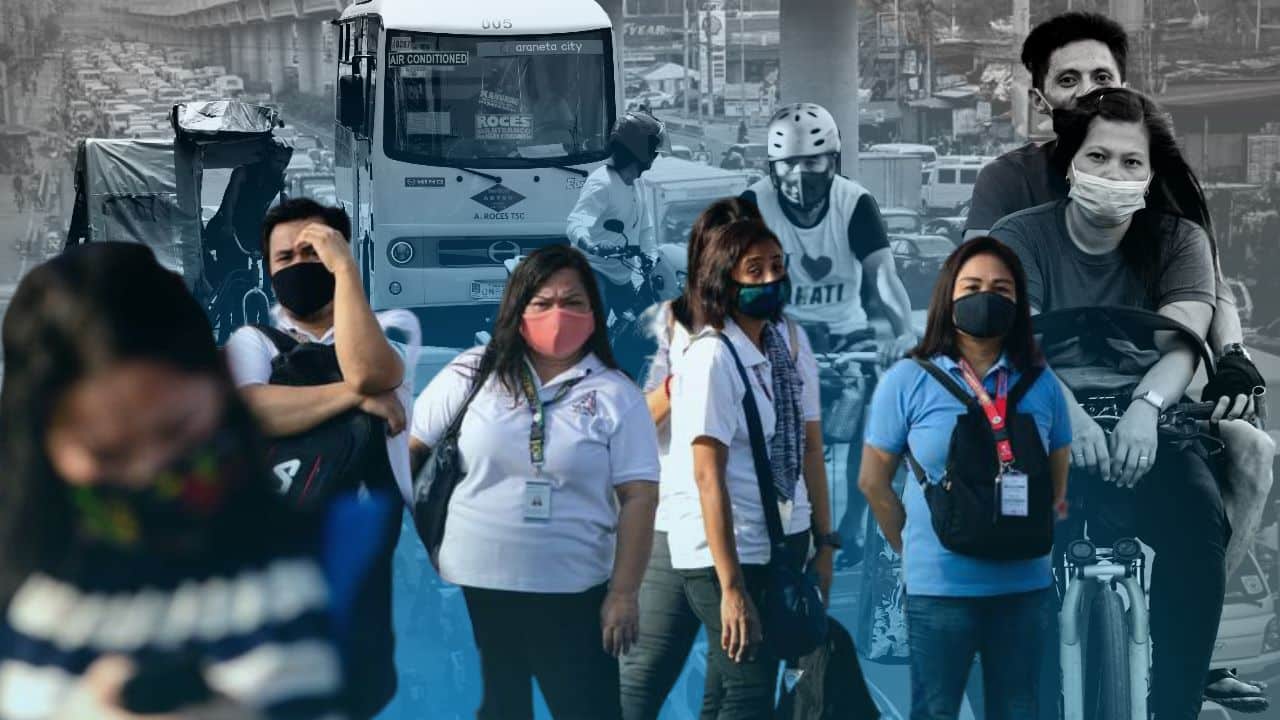INQUIRER.net composite image from file photos
(Last of two parts)
MANILA, Philippines—Philippine officials are betting on a robust and expanding middle class to drive the country’s transformation into a prosperous society by 2040, where every Filipino enjoys a life free from poverty and deprivation.
At a forum hosted by the Philippine Institute for Development Studies (PIDS), Dr. Rosemarie Edillon, undersecretary for National Development Policy and Planning at the National Economic and Development Authority (NEDA), highlighted that growing and strengthening the middle class are essential to achieving “Ambisyon Natin 2040.”
“Ambisyon Natin 2040” is the long-term vision launched by the National Economic and Development Authority (NEDA) in 2015 to create a predominantly middle-class society in the Philippines by 2040.
The vision aims for a future where all Filipinos enjoy a “matatag, maginhawa, at panatag na buhay” (strongly rooted, comfortable, and secure life), characterized by a high quality of life, strong family and community ties, and a society free from poverty.
Article continues after this advertisement
READ: Harmonizing AmBisyon Natin 2040 and Dream Philippines 2040
Article continues after this advertisement
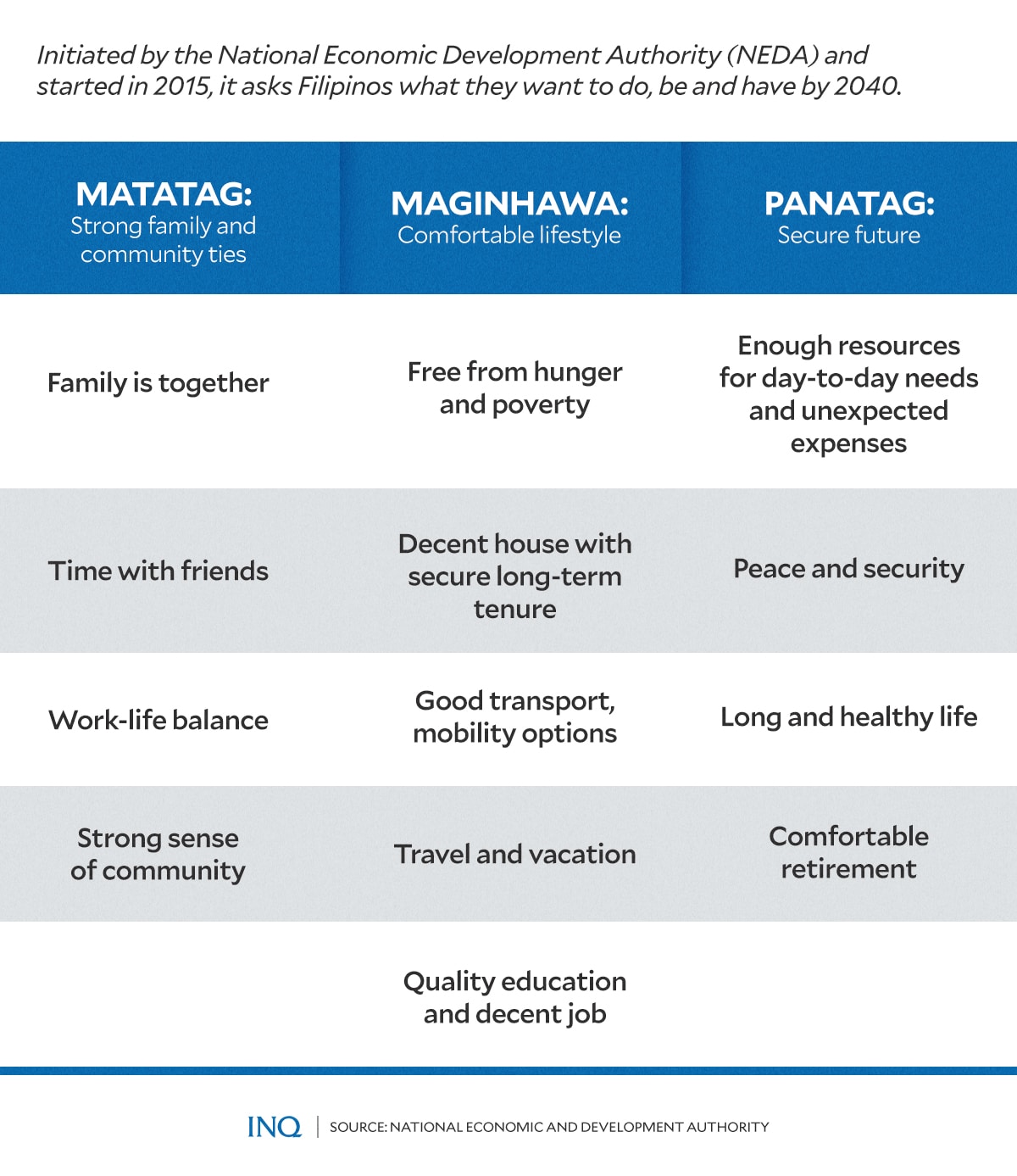
GRAPHIC: Ed Lustan / INQUIRER.net
“When you grow the middle class, obviously that means you reduce poverty,” Edillon said, but she added that “strengthening the middle class is another matter,” emphasizing the need for comprehensive reforms in social policies, governance, education, and economic opportunities to support this growth.
The first part of this two-part report discussed the obstacles hindering the Philippines from becoming a predominantly middle-class nation. Despite years of economic growth, widespread poverty, inequality, and inadequate access to quality education and health care continue to limit upward mobility for many Filipinos.
READ: PH a middle class country? Target still elusive
PIDS senior research fellow Dr. Jose Ramon G. Albert stressed that the government’s ambitious 2040 target cannot be realized without targeted interventions to close these socio-economic gaps.
Pathway for middle-class expansion
To transition to a predominantly middle-class society, Albert, along with fellow PIDS senior researchers Dr. Roehlano Briones and Dr. John Paolo Rivera, has laid out a comprehensive strategy that focuses on four key areas: social justice in resource management, trade opportunities for MSMEs, building a future-ready workforce, and improving digital governance and public services.
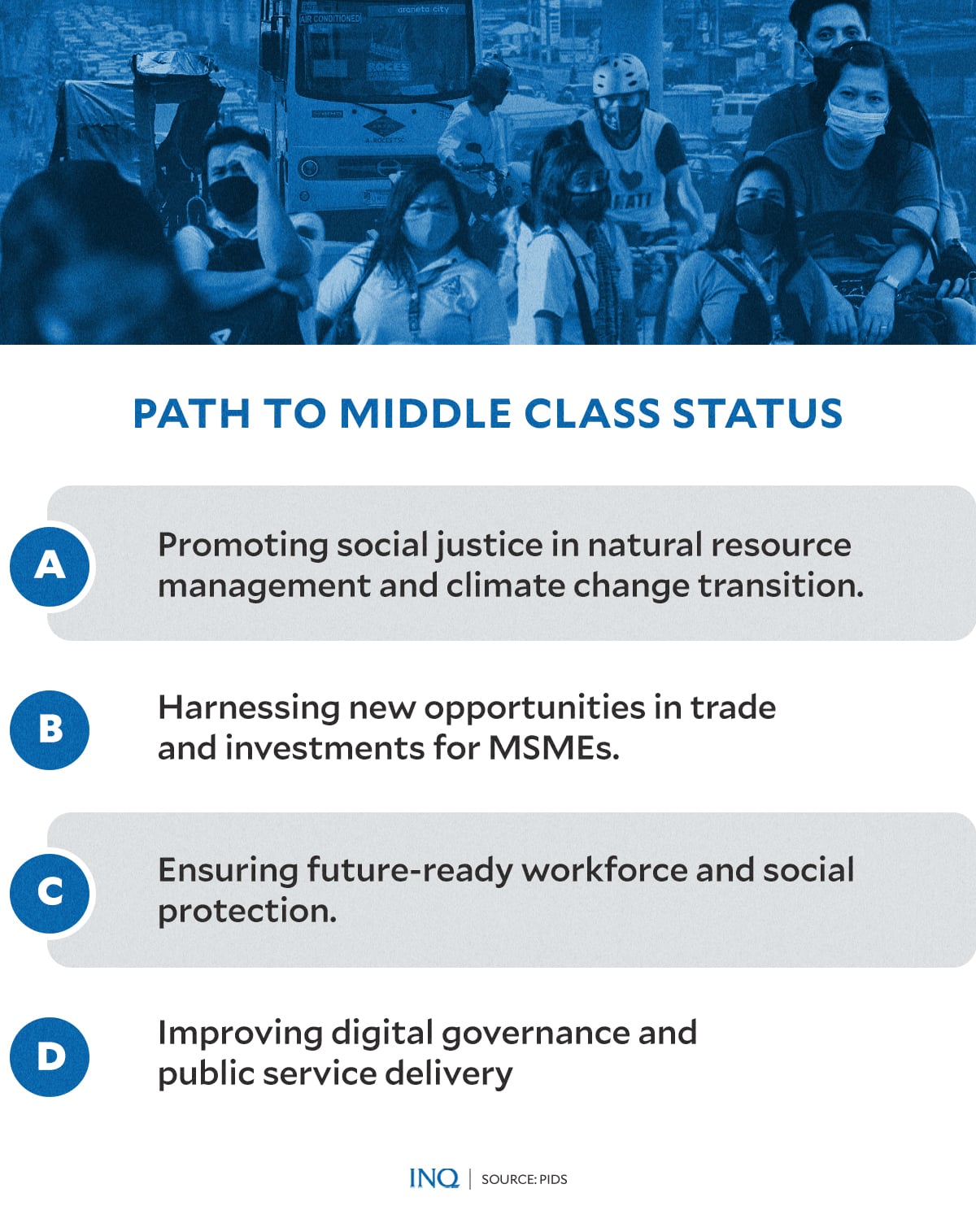
GRAPHIC: Ed Lustan / INQUIRER.net
“To harness the potential of the middle class as a driver of inclusive growth, we need [these strategies] not only to expand the middle class sustainably but also to transform it to a resilient middle class that can withstand welfare risks from megatrends that can further heighten existing inequalities,” said Albert during his presentation.
- Promoting social justice in natural resource management and climate change transition: Albert explained that this is essential to ensure that economic growth benefits are shared equitably and that the poor and vulnerable are not disproportionately affected by environmental degradation.
- The strategy advocates for sustainable resource management that involves communities, promotes green jobs, and supports policies to protect against climate impacts, ensuring inclusive growth in the shift towards sustainability.
- Harnessing new opportunities in trade and investments for micro, small and medium enterprises (MSMEs): This is key to overcoming growth barriers and expanding the middle class. MSMEs, which form the bulk of the Philippine economy, often face challenges like limited access to finance and markets.
- The strategy includes enhancing trade policies, capacity-building, and integrating MSMEs into global value chains to scale operations and innovate. Digital platforms are also encouraged to help MSMEs access wider markets and adopt productivity-enhancing technologies.
- Ensuring a future-ready workforce and strong social protection system: This strategy, according to Albert, is vital for helping individuals acquire the skills needed for higher-paying jobs and upward mobility.
- Aligning education and training with labor market needs, especially in STEM and emerging sectors, is emphasized. Expanding social protection coverage, such as health care and unemployment benefits, is also crucial to support those facing economic shocks and prevent them from falling back into poverty.
- Improving digital governance and public service delivery: The discussion paper stated that the strategy is crucial for enabling broader participation in the digital economy. This highlights the modernization of public services through digital technologies to enhance transparency and efficiency.
- Investing in digital infrastructure and promoting digital literacy are key to making government services more accessible and creating an inclusive digital economy where more Filipinos can benefit from technological advancements.
“[R]ealizing this vision of a predominantly middle-class society in the Philippines, as stated in AMBISYON 2024, will require bold and concerted action across multiple fronts,” said Albert.
“It will also necessitate effective leadership, cooperation, and collaboration among the government, the private sector, civil society, and development partners,” he added.
Redefining poverty
In her presentation, Edillon emphasized the need to redefine poverty and prioritize middle-class growth as key components of achieving Ambisyon Natin 2040.
She explained that poverty is assessed through various lenses — monetary, capability, participatory, and social exclusion approaches. However, she noted that NEDA recognizes poverty as a multi-dimensional issue that extends beyond these categories.
The Philippine Statistics Authority (PSA) defined poverty as “a characteristic of the family. Thus, if a family is classified as poor, then all members of the family will be counted as poor.”
“In other words, a family cannot have poor and non-poor members. Either all members are poor, or all members are not poor,” PSA added.
This perspective is reinforced by the need to broaden poverty metrics beyond income and expenditure surveys to include factors that capture overall wellbeing, such as access to quality education, healthcare, and social inclusion.
“We want to reduce poverty incidence as measured by the same metric,” Edillon explained.
She noted that while redefining the poverty threshold might be necessary in the future, it is “still too soon” to do so given the current recovery from the pandemic. The aim, however, remains clear: reduce poverty incidence to single digit by 2040 and ensure more Filipinos can move into and stay in the middle class.
Attaining a “strongly rooted, comfortable, and secure life”
According to the NEDA undersecretary, comprehensive reforms could reduce the cost of achieving a “matatag, maginhawa, at panatag na buhay” for Filipino families.
Currently, a family of four would need a monthly income of approximately P194,000 to live comfortably. This amount covers various expenses, including a budget for a car (P25,000) and a medium-sized home (P50,000 for a 20-year amortization).
It also allows for sending children to private schools to ensure quality education (P30,000), spending on leisure activities with family and friends (P10,000), saving for occasional international trips (P8,000), meeting daily living expenses (P50,000), and covering income tax obligations (P45,000).
However, Edillon argued that with strategic policy reforms — such as improvements in public transportation, affordable housing, quality education in public schools, and efficient health care — the cost of having a strongly rooted, comfortable, and secure life could be brought down to P92,000.
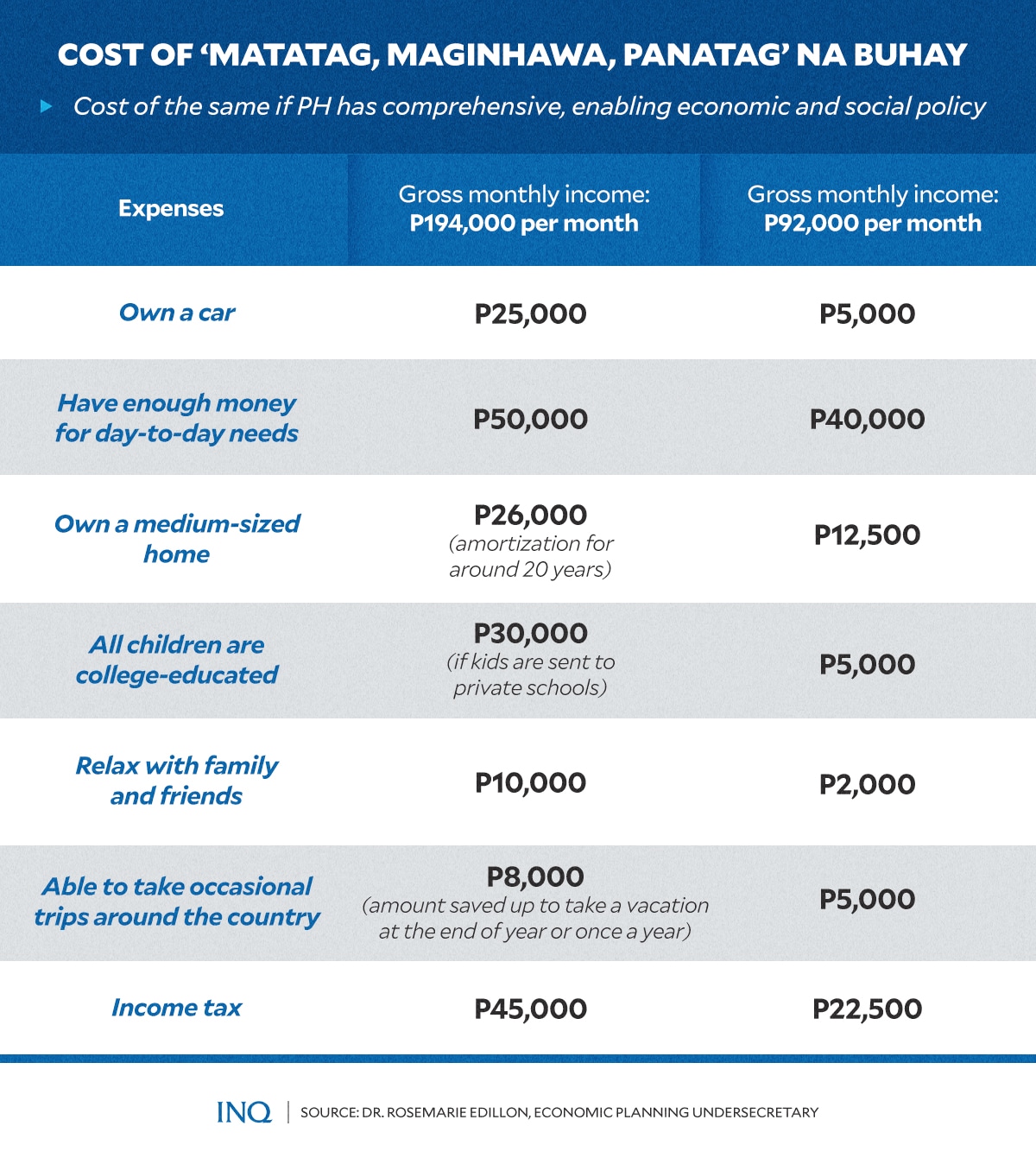

GRAPHIC: Ed Lustan / INQUIRER.net
“For instance, [having] a good transport [system] — safe, accessible, affordable — you don’t need to own a car,” she said, adding that strategic investments in sectors like housing, education, and healthcare are key to making the middle-class lifestyle more attainable for more Filipinos.
“[P92,000] is still a lot, but a far cry from P194,000 per month. And if it’s a two-income earner, then it is actually more achievable,” she stressed.
She emphasized that increasing women’s participation in the workforce is vital for enhancing household incomes and driving inclusive growth.
“That’s why even in the previous PDP (Philippine Development Plan), we were promoting, advocating heavily for increasing the female labor force participation rate because we know that is also a key to the Ambisyon,” she explained.
The PIDS discussion paper highlighted that women, in particular, face higher rates of unemployment in both the middle- and low-income classes compared to men, and they also have lower labor force participation rates across all income groups.
READ: World youth unemployment rate lowest for 15 years: UN
What to focus on?
Edillon also emphasized the importance of strategic investments in sectors that directly impact people’s aspirations.
Housing and urban development, manufacturing, connectivity, agriculture, tourism, and financial services were highlighted as key areas that can drive growth and improve quality of life.
Another crucial aspect of increasing accessibility to middle-class life, Edillon added, is implementing an enabling social policy for vulnerable and marginalized sectors. In her presentation, she highlighted the potential paths that an adolescent girl might take—either toward a life of opportunity and security or one marked by risk and instability.
On a positive trajectory, an adolescent girl could progress through school, obtain decent employment, experience adult marriage with healthy children, and achieve a secure place in society. Further support from policies that promote work-life balance and lifelong learning could lead to a demographic dividend, ensuring a secure old age.
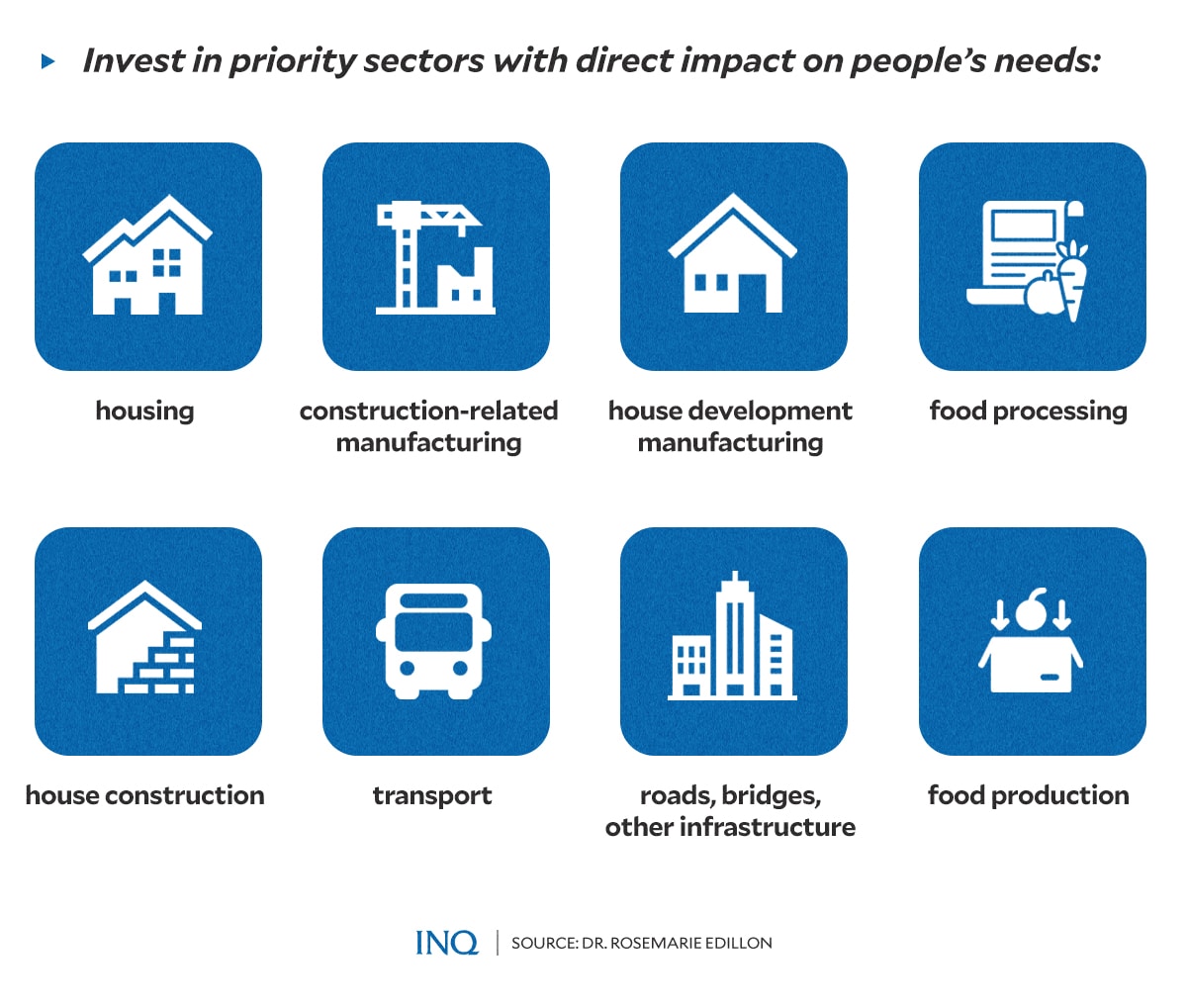
GRAPHIC: Ed Lustan / INQUIRER.net
However, without adequate support, the girl’s path could go awry. She may face challenges such as child marriage, leaving school early, repeat pregnancies, and adverse health outcomes like child illness and maternal morbidity or death.
These risks can lead to informal work, insecurity, and displacement, ultimately resulting in a missed demographic dividend and an insecure old age.
Edillon explained that enabling social policies are essential to guide the adolescent girl toward a better life. Key measures include comprehensive sexuality education, health-worker training, strengthened child health investments, laws against violence and discrimination, improved access to health services, and youth-friendly policies.
Additionally, promoting work-life balance, incentivizing saving, and establishing social safety nets can support her path to stability and opportunity.
“What we’re saying is, it doesn’t have to go all the way good or all the way bad. If you have these enabling social policies in the middle […] then even though they would sometimes detour to this bad path, we can bring them back,” she said.
‘Unwanted futures’
While “Ambisyon Natin 2040” envisions a predominantly middle-class society in the Philippines where every Filipino enjoys a life free from poverty, there are also futures that the country seeks to avoid.
In her presentation, Edillon also highlighted the concept of “unwanted futures”—scenarios that depict outcomes contrary to the goals of inclusive growth and development.
The three “unwanted futures” include:
- Masakuna (Distress and Disasters): This scenario represents a future where communities are increasingly vulnerable to disasters and economic shocks due to a lack of resilience and preparedness.
- Mabagal (Slow to Change): A future characterized by slow progress and delayed reforms, where the country’s development is stunted by bureaucratic inefficiencies, inadequate infrastructure, and lack of innovation.
- Langit-Lupa (Wider Inequalities): This depicts a future where economic growth benefits only a select few, leading to increased inequality and social divisions.
Edillon highlighted the disruptions caused by events such as the COVID-19 pandemic, emphasizing the importance of proactive planning and adaptive strategies to prevent these undesirable futures.
READ: PH still world’s most at-risk to disasters
“We know what is the future we want, but we also need to prepare for the future we do not want,” she stressed.
“We have actually come up with strategies so that we can avoid these futures that we do not want,” she continued, adding that it is crucial to ensure that robust, inclusive, and forward-thinking policies are in place to prevent the country from drifting toward these undesirable scenarios.
The path forward
The “Ambisyon Natin 2040” vision is anchored on the Philippine Development Plan (PDP) 2023-2028, which aims to create more jobs, reduce poverty faster, and guide the economy back to a high-growth path.
Edillon noted that the objective is to “steer the economy back on the high-growth path and, more importantly, effect economic transformation for a prosperous, inclusive, and resilient society.”
This involves aligning government policies and programs toward building a predominantly middle-class society where no one is left behind.
She emphasized the need for a collective effort from the government, private sector, and other stakeholders to make this vision a reality.
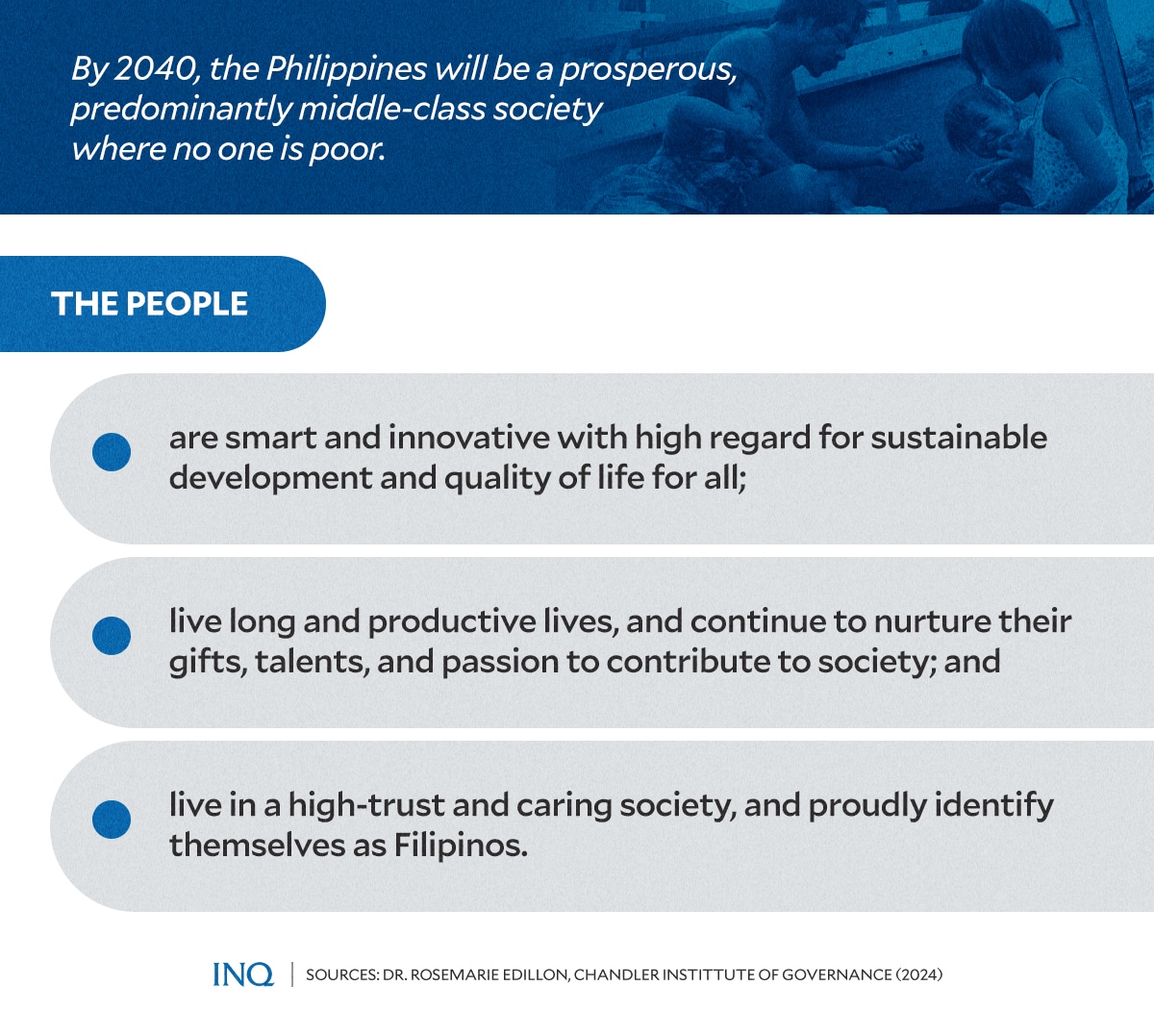
GRAPHIC: Ed Lustan / INQUIRER.net
“It’s about having a big and strong middle class because they know it’s education that can take them to the next level,” she said, highlighting the role of education and economic opportunities in empowering people to move up the socio-economic ladder.
Edillon also stressed that “what we need really is many more strategies that will provide them more ladder ranks so that they’re able to move up that social ladder.” She pointed out that for the poor, it’s not just about moving out of poverty but also about having social protection, like the 4Ps (Pantawid Pamilyang Pilipino Program), in place.
READ: Marcos orders 4Ps expansion to include pregnant, lactating women
“We also need other aspects to provide them the means to be able to move up that ladder,” she added, explaining that it’s not just one program or policy but a combination that helps strengthen the middle class.
RELATED STORIES:
Neda: PH can still achieve upper-middle income status by 2025
Angara: Proposed budget remains faithful to make PH middle-income nation
Metro Manila’s middle-class Gen Zs, millennials feel impact of inflation


